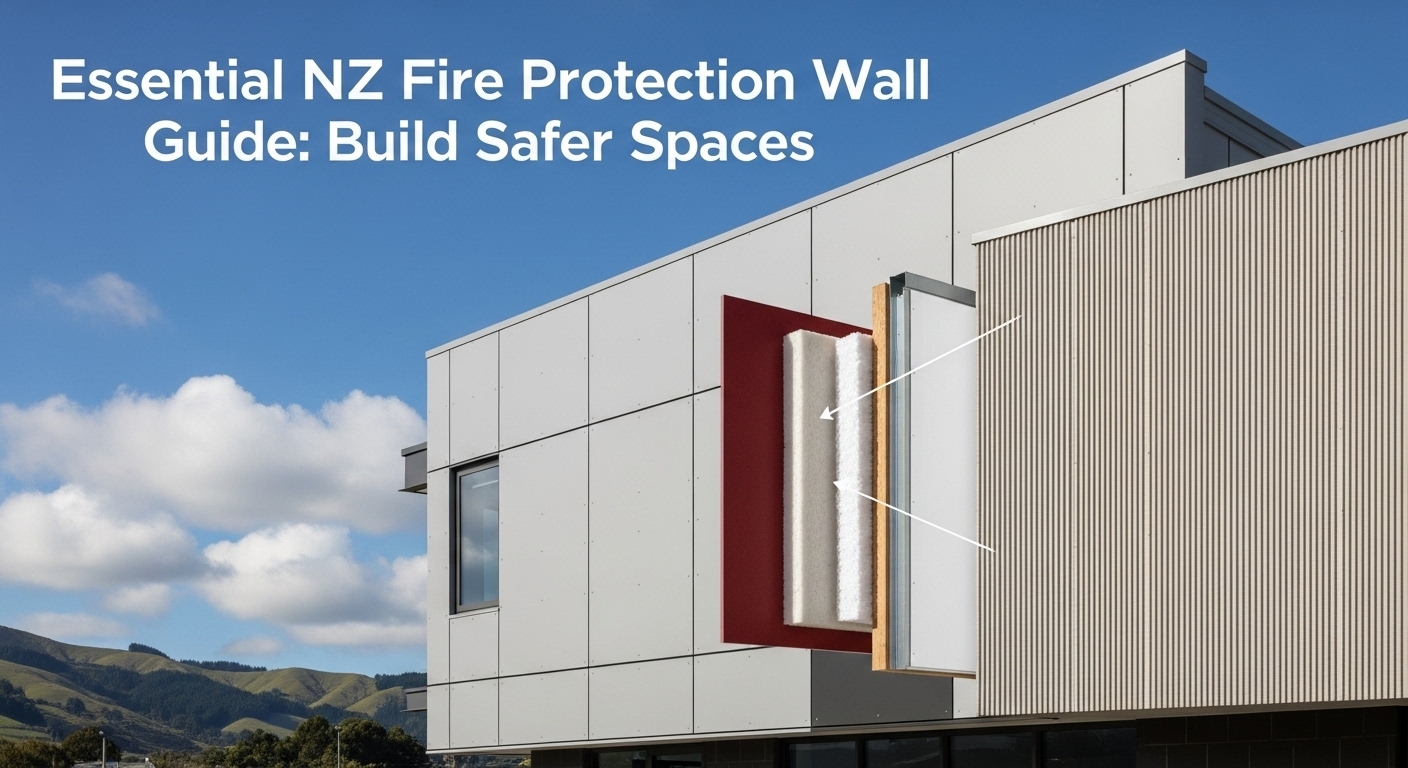The Critical Role of Fire Protection Walls
Essential NZ Fire Protection Wall Guide – Fire protection walls, also known as fire-rated walls or firewalls, are far more than simple dividers. Their primary function is to act as passive barriers that contain a fire within a specific area, or ‘compartment’, of a building. This strategy is foundational to a building’s overall fire safety design.
By slowing or stopping the spread of flames, smoke, and extreme heat, these walls serve several life-saving purposes. They protect crucial escape routes, providing occupants with the valuable time needed to evacuate safely. They also limit the structural damage to the building itself, containing the incident to the smallest possible area and protecting valuable assets. This compartmentalisation is a cornerstone of compliance with the New Zealand Building Code (NZBC).

Navigating the New Zealand Building Code (NZBC) for Fire Safety
Compliance is not optional; it’s the law. The NZBC provides a performance-based framework for building controls, and its clauses related to fire safety are among the most stringent. A thorough understanding of these requirements is the first step in any successful construction project. This section of our fire protection wall guide nz breaks down the key concepts.
Key Clauses: C1 to C6 ‘Protection from Fire’
The ‘C’ clauses of the NZBC are dedicated entirely to fire safety. While all are important, several are particularly relevant to fire protection walls. They set the performance criteria that any design solution must meet to be deemed compliant.
- C3 – Fire affecting areas beyond the fire source: This is the core clause related to compartmentalisation. It requires buildings to be designed and constructed to prevent the spread of fire to other properties and between different firecells within the same building. Fire walls are the primary means of achieving this.
- C4 – Movement to a place of safety: This clause ensures that occupants have a clear and protected path to evacuate. Fire-rated walls are essential for shielding stairwells, corridors, and other designated escape routes from the effects of a fire.
- C6 – Structural stability: This clause mandates that a building’s structure must withstand the effects of a fire for a specified duration, preventing premature collapse. The stability rating of a fire wall contributes directly to meeting this requirement.
Understanding the Fire Resistance Rating (FRR)
The performance of a fire protection wall is measured by its Fire Resistance Rating (FRR). This is a critical metric expressed in minutes, indicating how long a wall system can withstand a standard fire test while maintaining its structural and containment functions. The FRR is presented as a series of three numbers, for example, 60/60/60 or -/30/30.
- Stability: The first number represents the time in minutes that the wall can remain standing and bear its load during a fire. A non-load-bearing wall will be represented by a dash (
-). - Integrity: The second number is the time in minutes that the wall will prevent the passage of flames and hot gases. This is crucial for stopping the fire from spreading through cracks or openings.
- Insulation: The third number indicates the time in minutes that the wall will limit the temperature rise on the non-fire side. This prevents combustible materials on the other side of the wall from spontaneously igniting due to radiant heat.
For example, a wall with an FRR of 60/60/60 is a load-bearing wall expected to maintain stability, integrity, and insulation for at least 60 minutes in a standard fire test.
How to Determine Your Building’s FRR Requirements
The required FRR for a wall is not a one-size-fits-all figure. It is determined by several factors outlined in the NZBC Acceptable Solutions or through specific fire engineering design. Key factors influencing the required FRR include:
- Building Use (Purpose Group): A hospital or a large assembly building will have more stringent requirements than a small, standalone office.
- Building Height and Size: Taller and larger buildings generally require higher FRRs to allow more time for evacuation and firefighting.
- Firecell Type: The walls separating different tenancies (apartments, retail shops) or high-risk areas (like a boiler room) require specific FRRs.
- Proximity to Boundaries: Walls close to property boundaries need higher FRRs to prevent fire spreading to neighbouring buildings.
Consulting with a fire engineer or using the NZBC Acceptable Solutions documents (e.g., C/AS1 and C/AS2) is essential to accurately determine the FRRs for your specific project.
A Deep Dive into Fire-Rated Wall Systems and Materials
Achieving a specific FRR depends on using a complete, tested system, not just individual materials. The entire assembly—from the framing and linings to the fixings and insulation—works together to provide the required fire resistance. This section of our comprehensive fire protection wall guide nz details the most common systems used.
Common Materials and Systems in NZ
New Zealand construction utilises several proven materials and systems to build effective fire protection walls. The choice often depends on factors like the required FRR, cost, acoustic performance, and structural requirements.
Fire-Rated Plasterboard Systems
By far the most common method for creating fire-rated walls in residential and light commercial construction is using fire-rated plasterboard. Brands like GIB® are ubiquitous in New Zealand and offer a wide range of tested systems.
The magic of fire-rated plasterboard lies in its composition. It contains a high percentage of chemically-bound water (calcium sulphate dihydrate). When exposed to intense heat, this water is released as steam, a process called calcination. This process absorbs significant heat energy, keeping the temperature on the non-fire side of the board down and slowing the fire’s progress. Achieving a specific FRR requires adhering strictly to the tested system’s specifications, which include:
- Number and Thickness of Linings: Systems may require one, two, or even three layers of specific fire-rated plasterboard on each side of the frame.
- Framing Type: The size, gauge, and centres of the steel or timber studs are specified.
- Fixings: The type, length, and spacing of screws are critical to hold the linings in place during a fire.
- Insulation: Some systems require a specific type and density of insulation (e.g., glass wool or rock wool) within the wall cavity to achieve the insulation rating.
Concrete and Masonry Walls
Concrete and masonry are inherently non-combustible and offer excellent fire resistance. These materials are frequently used for inter-tenancy walls in multi-unit residential buildings, commercial separation walls, and for structures where durability and high fire ratings are paramount.
Common solutions include:
- Concrete Blocks: Standard concrete masonry units (CMUs) can provide high FRRs. The rating depends on the block’s thickness and whether the cores are filled with grout.
- Precast Concrete Panels: These panels are manufactured off-site and craned into position, offering a fast and highly effective method for constructing robust firewalls with excellent FRRs of up to 240 minutes.
- Autoclaved Aerated Concrete (AAC): AAC panels are a lightweight concrete product that offers both structural and fire-rating properties in a single solution.
While inherently robust, the FRR of a concrete or masonry wall still depends on correct installation, particularly regarding the mortar joints and the connections to other building elements.
The Critical Importance of Penetrations and Junctions
A fire protection wall is only as strong as its weakest link. Any opening or gap in the wall, no matter how small, can compromise its integrity and insulation performance, allowing fire and smoke to pass through. This is why managing penetrations is one of the most critical aspects of fire wall construction.
Common penetrations that must be properly fire-stopped include:
- Ducts: For HVAC systems.
- Pipes: For plumbing, sprinklers, and gas lines.
- Cables: For electrical, data, and communication services.
- Conduits: For sheathing electrical wiring.
Every service that passes through a fire-rated wall must be sealed using a tested and compliant passive fire protection product. These products are designed to swell or char when heated (a process called intumescence), sealing the opening and reinstating the wall’s FRR. Common fire-stopping products include:
- Fire Mastics and Sealants: Flexible sealants applied around cables and pipes.
- Pipe Collars and Wraps: Intumescent devices that fit around plastic pipes and crush them when heated to seal the void.
- Fire Pillows and Mortars: Used for larger, more complex openings.
It is absolutely essential that fire-stopping is carried out by specialist, certified installers using products that have been tested and approved for the specific application and wall type. Similarly, the junctions where fire walls meet floors, ceilings, and other walls must also be detailed and sealed correctly to maintain continuity of the fire rating.

The Installation Process: Precision and Compliance are Key
Designing a compliant fire protection wall is one thing; building it correctly is another. The on-site installation process is where the theoretical performance becomes a reality. Even minor deviations from the tested system specifications can lead to a catastrophic failure of the wall in a real fire.
The most important rule is to follow the manufacturer’s technical literature to the letter. Generic building practices are not sufficient for fire-rated systems. Every detail matters, from the first stud to the final coat of paint. Installers, often Licensed Building Practitioners (LBPs), must be familiar with the specified system and execute it with precision.
Key areas of focus during installation include:
- Correct Materials: Double-check that all materials delivered to the site—plasterboard type, stud gauge, insulation density, screw type—match the system specification.
- Framing and Fixing: Ensure stud spacing, nogging, and fastener patterns are exactly as detailed. Over-driving or under-driving screws in plasterboard can compromise its holding ability.
- Control Joints: For long or tall walls, control joints must be incorporated as specified to manage expansion and contraction without compromising the fire rating.
- Penetration Sealing: Co-ordinate with other trades (plumbers, electricians) to ensure all penetrations are properly planned and sealed by a competent person using a tested system.
Upon completion, proper documentation, such as a Producer Statement for Construction (PS3), provides evidence that the wall has been installed in accordance with the specified design. This documentation is crucial for obtaining a Code Compliance Certificate (CCC). A detailed fire protection wall guide nz is incomplete without stressing that meticulous installation is as important as the design itself.
Conclusion: Building Resilience Through Compliant Fire Protection
Fire protection walls are a fundamental element of building safety in New Zealand. They are not merely lines on a blueprint but active defenders of lives and property, engineered to perform under the most extreme conditions. Their effectiveness hinges on a chain of responsibility that extends from the architect’s design to the builder’s final quality check.
This guide has provided a comprehensive overview, from understanding the New Zealand Building Code and Fire Resistance Ratings to selecting the right materials and ensuring flawless installation. Remember that compliance is the baseline, not the ceiling. By embracing the principles of passive fire protection and committing to quality from start to finish, we build more than just code-compliant structures; we build resilient communities and a safer future for all New Zealanders. Investing in a properly designed and installed fire protection wall is one of the most important investments you can make.






